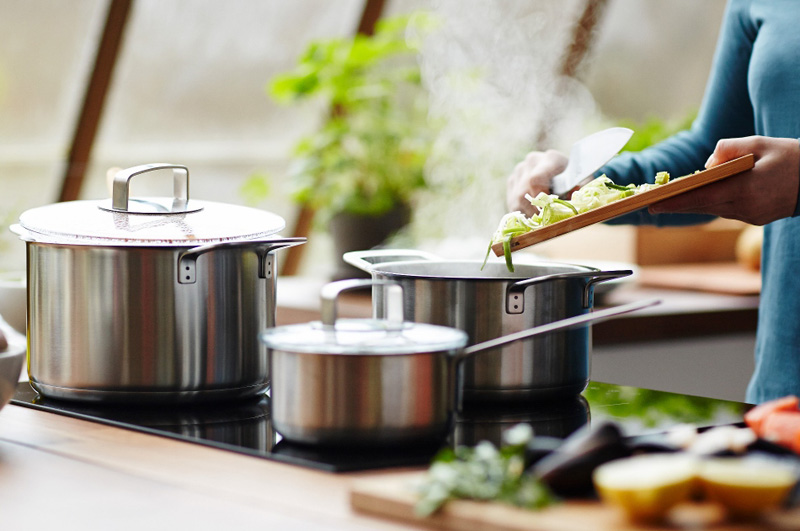Very few people think about whether or not the cookware sets that they’re buying and using are safe and healthy for themselves and their families. After all, the different kinds of pot and pans are pretty much the same, right?
Wrong! Depending on what your pots and pans are made out of, you could be endangering your health or the health of your loved ones.
In order to help you better understand what to keep in mind when shopping for cookware, we’ve assembled the following information. We hope you find it helpful!
What To Look For
There are a few key factors to consider when trying to select the safest and healthiest cookware set. We don’t want to overwhelm you with too much information, though, so in the interests of keeping thing simple, here are the two things we consider to be the most important and why.
1.Materials: What is the cookware made out of?
What your pots and pans are made out of is without a doubt the most important factor to consider. Here are some important facts and tips to keep in mind when choosing your cookware based on the material it’s made of.
Avoid aluminum cookware whenever possible; aluminum can leach into food very easily and has been linked to health problems involving memory loss and potentially even Alzheimer’s. Aluminum is also more easily damaged, so cookware made of it will not have a very long lifespan.
Also be wary of certain non-stick coatings such as Teflon.While more research is needed, there is evidence linking exposure to these materials to certain types of cancer and other illnesses. Ceramic non-stick coatings are a better option; there are no harmful chemicals contained in ceramic coatings that we know of.
Glass cookware, like ceramic, will not have any harmful chemicals or toxins in it. The downside is that glass dishes are typically heavier than their metallic counterparts and are also more prone to breakage.
Cast iron cookware, like glass, is heavier than cookware made of other materials but has many benefits that outweigh that factor. Not only are cast iron pots and pans free of any potentially harmful chemicals, but they are also incredibly durable and will likely last for years if cared for properly. Do bear in mind, however, that you need to be careful when boiling water or cooking with other liquids; doing so can leach iron out of the pan and into your food and throw off the balance of nutrients in your meal.
Carbon steel is also a good option for frying pans, because it’s lighter than cast iron but also without any harmful chemicals or additives. Unfortunately, carbon steel doesn’t fare as well when turned into pots or deep cooking dishes, so if you need a matching set of cookware carbon steel may not be an option.
Copper is also not a good choice because of how it leaches into whatever food you’re cooking, which poses a health risk; the FDA has been issued warnings for using copper, particularly if it’s unlined or untreated.
Overall, there are a variety of pros and cons to each option, and you’ll need to carefully consider all the potential benefits and hazards before deciding what material you would like your cookware to be made out of.
2.Condition: New or Used?
Whether your cookware set has been used by owners before you is also an important factor to consider. Depending on the materials it’s made out of and how much abuse it took in its previous home, your cookware set could be in pristine shape or about to kick the bucket.
Thinner and more fragile pieces of cookware could have sustained damage before coming to you, and we also advise you to be especially careful of any non-stick or Teflon-coated pots or pans you may receive; if the special coating has been scratched at all, the chances of harmful chemicals leaching into your food increase exponentially.
All in all, buying a cookware set new is the best option if you want a pristine cooking set from the start, without any risk of previous damage to the dishes posing a risk to you or your family’s health, but there are some types of pots and pans that can be used second-hand.
Cast iron and carbon steel are, as previously mentioned, incredibly durable, and as such can last a good long while and pass from household to household with little concern for damage or contamination. Many families have cast iron pans that have been in their family for generations.
Buying a used cookware set could also be a good option for you if you have a smaller budget and don’t want to break the bank buying cookware.
Buying a cookware set used is indisputably cheaper than buying a brand new one, particularly if you find the set you need at a thrift store or another small shop that specializes in used goods.
Just like when deciding what material you want your cookware to consist of, though, whether you want to use an entirely new set or a previously owned set is a decision that needs to be carefully considered.
Conclusion
As you can see, selecting the right cookware set for yourself and your family is a much more involved process than you would think.
But if you keep in mind the two key factors we’ve discussed here (what the pots and pans are made out of and whether they are new or used), you should have very few problems in selecting a cookware set that’s both safe for your family and effective in the kitchen.
If you have any additional questions or would like to add in a bit of your own advice about what to consider when buying safe and healthy cookware, we’d love to hear from you in the comments section down below.








